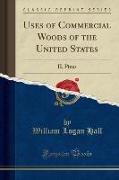Uses of Commercial Woods of the United States
BücherAngebote / Angebote:
Excerpt from Uses of Commercial Woods of the United States: II, Pines
Thirty-seven species of pine grow in the United States, no one species in all the States, yet, with perhaps one exception, no State is without one or more. Some, as the loblolly pine of the South, the white pine of the North and East, and the western yellow pine, occupy large regions in considerable abundance, while others, as the Apache pine of the Chiricahua Mountains of Arizona, the Torrey pine along the Soledad River in California, and the sand pine near the Gulf coast of Florida and Mississippi, are so scarce that few persons ever see and recognize them. Yet no species of pine is so scarce that it is not made in some way to serve man's needs.
About 48 percent of the total lumber output for the United States in 1908 was pine. The longleaf probably furnished more than any other single species, and white pine was next. The western yellow pine, which is more widely distributed than any other pine of this country, is a large producer of lumber, and the western white pine and the loblolly also rank high in quantity. This bulletin considers each species separately. The places which some species occupy are very humble, and they can never rise much in the scale of usefulness, yet each one is entitled to its own individuality.
Four important timber trees of the southeastern United States are usually grouped as one in the lumber market, and are sold under the common name of yellow pine. They are the longleaf pine, shortleaf pine, loblolly pine, and Cuban pine. In appearance the woods of these four trees are so nearly alike that it is sometimes difficult to distinguish one from the other, yet in some particulars there is considerable difference. This is often seen in the growth rings. Longleaf annual rings are usually narrow, shortleaf wide near the heart, followed by a zone of narrower rings, while loblolly's rings are generally very wide. The Cuban pine also has wide rings. The proportion of sapwood to heart is usually different in the four species.
About the Publisher
Forgotten Books publishes hundreds of thousands of rare and classic books. Find more at www.forgottenbooks.com
This book is a reproduction of an important historical work. Forgotten Books uses state-of-the-art technology to digitally reconstruct the work, preserving the original format whilst repairing imperfections present in the aged copy. In rare cases, an imperfection in the original, such as a blemish or missing page, may be replicated in our edition. We do, however, repair the vast majority of imperfections successfully, any imperfections that remain are intentionally left to preserve the state of such historical works.
Folgt in ca. 5 Arbeitstagen



